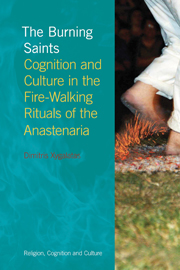Book contents
- Frontmatter
- Dedication
- Contents
- List of illustrations
- Acknowledgements
- 1 Introduction
- 2 Tradition in the making
- 3 The ethnographic setting
- 4 Fire-walking in Agia Eleni
- 5 Knowledge and revelation among the Anastenaria
- 6 Ritual and mind
- 7 Costly rituals
- 8 Arousal, emotion and motivation
- 9 The physiology of high-arousal rituals
- 10 Putting it all together
- Notes
- Bibliography
- Index
7 - Costly rituals
- Frontmatter
- Dedication
- Contents
- List of illustrations
- Acknowledgements
- 1 Introduction
- 2 Tradition in the making
- 3 The ethnographic setting
- 4 Fire-walking in Agia Eleni
- 5 Knowledge and revelation among the Anastenaria
- 6 Ritual and mind
- 7 Costly rituals
- 8 Arousal, emotion and motivation
- 9 The physiology of high-arousal rituals
- 10 Putting it all together
- Notes
- Bibliography
- Index
Summary
Rituals such as the Anastenaria, which involve activities that often appear to be stressful, unpleasant or even dangerous, pose an important question regarding the motivation of their participants. In many rituals, such as various initiation rites, participation is coerced or encouraged by social norms and peer pressure, and failure to undergo the ordeal might have dire consequences, such as corporal punishment, social ostracism or even death. Janice Boddy (1989) described how a girl who grew up among the Zār of northern Sudan could not get married or have children, and as a result could not have a respectable place within her society, unless she underwent a painful ritual of genital mutilation before her wedding. Ted Strehlow (1971) wrote about the initiation rituals of the Aranda Aboriginals, where boys suffered brutal beating, burning, biting, scarring and tearing of the fingernails without resisting, under penalty of death. Yet, there are many other rituals, such as the Anastenaria, which people perform voluntarily, without any – or even against – social pressure. The question, therefore, is why are many individuals willing to participate in ritual activities that would normally intimidate or seem appalling to most people? In this chapter, I will discuss some of the theories that have been proposed to explain this perplexing behaviour. But before discussing why people perform a certain category of rituals, we should begin with a more basic question: Why do people perform rituals in the first place?
- Type
- Chapter
- Information
- The Burning SaintsCognition and Culture in the Fire-Walking Rituals of the Anastenaria, pp. 125 - 136Publisher: Acumen PublishingPrint publication year: 2012



